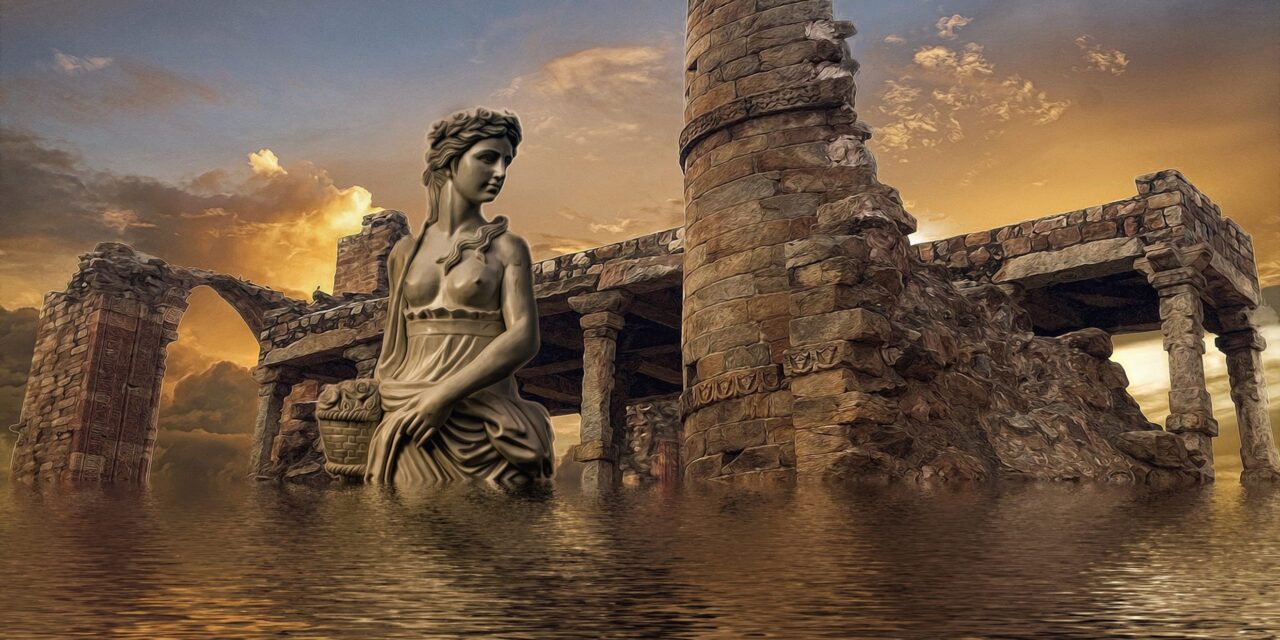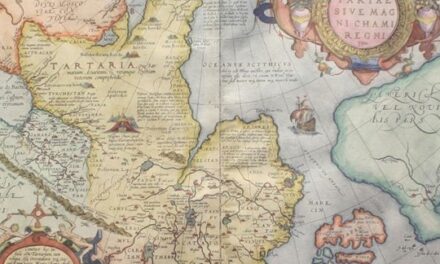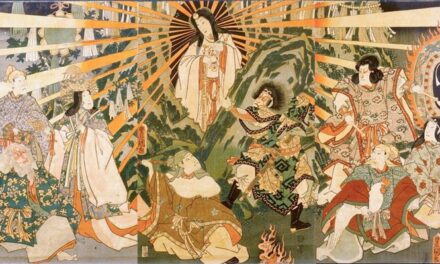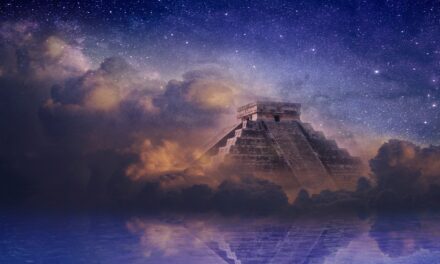We consider impossible that Plato could have accessed to the Texst of the Archaic-Scholarly Discipline. Not only because if he had done so and if he had understood them well, his descriptions of “Atlantis” would have been much more detailed, but because at the time Plato lived, these texts were jealously guarded in the Mother Sanctuary of Eleusis, and they were the exclusive prerogative of high-grade Initiates within the Priestly Schools. It is true that Plato was undoubtedly also an Eleusinian Initiate, but as far as we
know he never had to go to Eleusis beyond the Mysta, the first degree of Initiation, which certainly would not have allowed him any access to libraries and archives. And his initiatory path subsequently continued in Egypt and, in Greece, within circles of Orphic Eleusinity (which were bound by a more moral than formal status of submission to the Mother Eleusinity and which in reality were in fact totally autonomous) , up to its final landing in the Pythagorean Order, between which and the Eleusinity Mother an abrupt break had already taken place due to political and doctrinal issues.
However, regardless of the considerations expressed up to now, the dialogues of Plato Critias and Timaeus, once we have taken note of their limitations and the partiality of the vision they offer us, are far from being rejected and offer us numerous margins of reliability . In fact, we must not run the risk of throwing, as they say, the baby together with the bathwater. And let’s see why.
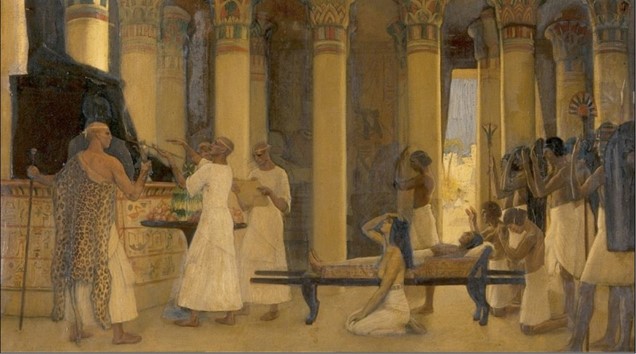
Egyptian priests reciting an invocation to the deified Imhotep in a 1912 painting by Ernest Board; London, Wellcome Library
Solon, the Athenian legislator who lived from 630 to 558 BC, during a trip to Egypt, according to various ancient sources, would have had the opportunity to see inscriptions made six centuries earlier by the Pharaoh Ramses IIIth on the walls of the Temple of Medinet Habu, inscriptions which referred to events that occurred thousands of years earlier and related to the disappearance of a great previous civilization following a sudden catastrophe. Taking an interest in them, he had them translated into Greek by the Theban Sonchis, certain that he was dealing with documents of great importance that perhaps he intended to use for his works. The great Initiate and writer of antiquity Plutarch of Chaeronea (46-125 AD), in his Life of Solon, instead tells us that the latter would have had the opportunity to learn the story of “Atlantis” from the priests of the Temple of the Goddess Neith in Sais (today’s Sa El-Hagar), a very ancient city called in the Egyptian language Zau, on the Eastern bank of the Rosetta branch of the Nile, in Lower Egypt. In fact, Plutarch tells us that Solon “went to Egypt and lived there for some time, as he himself affirms, “at the mouth of the Nile, on the shores of illustrious Canopus”. He stayed with Psenofe Eliopolita and Sonchino Saita, very learned among the priests
of Egypt, and waited to discuss Philosophy with them, learning there what was said of Atlantis, as Plato wrote, and proposing to tell it in Greek verses [1]. And again: «Solon then set about writing about Atlantis, of which he had heard of the scholars of Sais, a work of great commitment and useful to the Athenians, which, however, did not go ahead, not because it was busy, as Plato relates, but because it prevented from the old age and the vastness of the work» [2].
A confirmation of this can also be found in the Stories of Herodotus and in the Historical Library of Diodorus Siculus [3]. Furthermore, it is clear from what Plutarch reports, that the information collected by Solon could have been much higher and more extensive than that then acquired by Plato and reported in his dialogues.
In any case, regardless of where Solon actually acquired certain information (we cannot absolutely exclude that he collected it in several phases and in several distinct places during his stay in Egypt), and that old age and death would have prevented the great legislator to make use of them or to create the hoped-for work in verse to which the sources refer, there is no reason to doubt that they actually reached Plato, a few decades later (who, it should not be forgotten, was a Solon’s descendant). The latter, as reported by Proclus (the great Neoplatonist Initiate and Philosopher, as well as the second greatest guide of the Eleusinians during the phase of clandestinity, a sacred title that he had received and inherited from Plutarch of Athens), went personally to Egypt in search of
confirmations that proved the veracity of Solon’s notes. Thus Plato arrived first in Sais, where he had an interview with the High Priest Pateneit, then in Heliopolis, where he met the Priest Ochlapi, and finally in Sebenytus, where he was able to speak with the Hierophant Ethimone. And, as various sources would attest, all three of these authoritative men of religion would have confirmed to the Philosopher the veracity of the story and of the events that Solon had learned some time before.
The presence and stay in Egypt of Plato receive confirmations from various sources, some of which even tell us of a stay of thirteen years of the Athenian Philosopher in the land bordered by the Nile, during which he would also have received some particular initiatory teachings in Heliopolis and in Memphis. This detail is confirmed by the philosopher Hermodorus of Syracuse, a disciple and a friend of Plato’s during the travels that he made in Sicily between 388 BC. and 360 BC, and also by Strabo, who in his
Geography, returning from his trip to Egypt, wrote: “We have seen buildings once intended to house priests, but that is not all: we were also shown the abode of Plato and Eudoxus, because Eudoxus had accompanied Plato up to there. Arrived in Heliopolis. They settled there and both lived there for thirteen years in the community of priests (…). These priests, so deeply versed in the knowledge of celestial phenomena, were at the same time mysterious people, not very communicative, and it is only with the passage of time and the skillful shrewdness that Eudoxus and Plato were able to obtain to be initiated by them into some of their theoretical speculations. But these barbarians kept the best part for themselves, hidden away. And if the world owes them today the knowledge of how many fractions of days it is necessary to add to the three hundred and sixty-five full days to obtain a complete year, the Greeks ignored the true length of the year and many other facts of the same nature, until some translations into the language Greek of memoirs of the Egyptian priests spread these notions among modern astronomers, who have continued to this day to draw extensively on this same source as on the writings and observations of the Chaldeans”[4].
La presenza ed il soggiorno in Egitto di Platone ricevono conferme da varie fonti, alcune delle quali ci parlano addirittura di una permanenza di ben tredici anni del Filosofo ateniese nella terra bagnata dal Nilo, durante i quali egli avrebbe anche ricevuto particolari insegnamenti iniziatici a Heliopolis e a Memphis. Questo particolare ci è confermato in particolare dal Filosofo Ermodoro di Siracusa, allievo e amico di Platone nel corso dei viaggi che lo stesso fece in Sicilia tra il 388 a.C. e il 360 a.C., e anche da Strabone, che nella sua Geografia, di ritorno dal suo viaggio in Egitto, scrisse: «Abbiamo visto degli edifici destinati un tempo ad ospitare i sacerdoti, ma non è tutto: ci fu mostrata anche la dimora di Platone e di Eudosso, perché Eudosso aveva accompagnato Platone sino a lì. Arrivati a Eliopoli, vi si stabilirono ed entrambi vissero là per tredici anni nella comunità dei sacerdoti (…). Questi sacerdoti, così profondamente versati nella conoscenza dei fenomeni celesti, erano allo stesso tempo delle persone misteriose, poco comunicative, e non è che con il passare del tempo ed abili accortezze che Eudosso e Platone poterono ottenere di essere iniziati da essi ad alcune delle loro speculazioni teoriche. Ma questi barbari conservarono per sé, nascosta, la parte migliore. E se il mondo deve loro di sapere oggi quante frazioni di giorni bisogna aggiungere ai trecentosessantacinque giorni pieni per ottenere un anno completo, i Greci hanno ignorato la durata vera dell’anno e molti altri fatti della stessa natura, sino a quando delle traduzioni in lingua Greca delle memorie dei sacerdoti egiziani hanno diffuso queste nozioni tra gli astronomi moderni, che hanno continuato sino ad oggi ad attingere ampiamente in questa stessa fonte come negli scritti ed osservazioni dei Caldei»[4].
The presence and stay in Egypt of Plato receive confirmations from various sources, some of which even tell us of a stay of thirteen years of the Athenian Philosopher in the land bordered by the Nile, during which he would also have received some particular initiatory teachings in Heliopolis and in Memphis.
If the mathematician and astronomer Eudoxus of Cnidus, a disciple of Plato’s, had turned to his friends to finance his trip to Egypt, Plutarch of Chaeronea tells us that Plato had to transform himself into a skilled merchant to meet the expenses of the trip («Plato sustained his travel expenses by selling oil in Egypt“). In practice he began to send cargoes of oil produced by his olive groves to Egypt by ship.
Again with regard to Plato’s stay in Egypt, it is interesting what the French scholar Roger Godel wrote in the 1950s: “If the guides from Strabo’s times were able to show the room in which Plato resided for several years near the temple, it is because the stay was useful to him. Since a century, Egyptian sanctuaries had accredited interpreters to converse with the Greeks. Qualified travelers had been received, educated and sometimes initiated: Solon, Pythagoras, Herodotus, Democritus (…). About the teaching of the Egyptian priest Sechnuphis we can read: “Plato listens as he was listening to Socrates exalting the right way in front of the prospects of death (…)”. If Plato came to converse with the highest dignitaries of Heliopolis, as his disciple Hermodorus has stated in writing, the communications he received must have belonged to a perfectly unified background. The communities of Heliopolis offered a researcher immense resources. Provided that he was liked and trusted, he could consult through a third party libraries of inestimable value, a collection of continuous astronomical observations of millennia”[5].
The most current objection from critics and skeptics of all times compared to the truthfulness of the story of “Atlantis” presented by Plato in Timaeus and Critias is that the Athenian philosopher intended to propose it as a sort of imaginary narration, a mere philosophical allegory of his ideal society, already exemplarily stated years earlier in the Republic, and which he intended, through the maieutic technique of philosophical dialogue, to build a scheme of social life that was at the same time rational and scientific and
capable of understanding within himself the moral and religious aspects of human nature. Works therefore, in the opinion of one of the skeptics and deniers par excellence, the British Paul Jordan, aimed at developing the theme of humanity’s place in the whole universe, of being from first principles: from the origins and nature of the world through history to an understanding of the best way life should be lived by human beings [6].
But it seems clear and evident that the description of “Atlantis” offered to us by Plato does not represent at all a mirror image of the society described in the Republic. Between the two visions there are significant differences, in many points even irreconcilable. The authoritarian ideal of a regime governed by a dynasty of Philosopher-Kings was based on the existence of a single state of imperial and imperialist matrix, aware and guardian of its roots, and not on an extended confederation of different peoples, united under a single old system of monarchs who were prevented from exercising absolute power because they were subject to the authority of a council made up of members of equal rank.
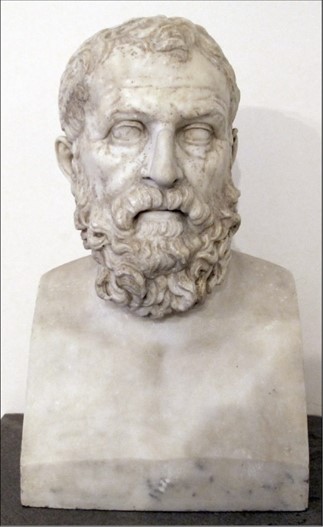
Marble bust of Solon. Roman copy from the 1st century AD. from a Greek original; Naples, National Archaeological Museum
As observed by Frank Joseph [7], even if the story of “Atlantis” had been in some way inspired by the Republic (but this is not the case), the addition of a considerable amount of supplementary material of a non-philosophical nature ( such as the detailed description of the architecture of cities, ports, canals, racecourses, and so on) could not have served to further illustrate what was already treated effectively in the Republic, and therefore it would have been a superfluous repetition, something very rare in the work of this great author.
His story can be more correctly framed if we take into account that he did not want to and had to be a sort of work in its own right, a kind of anomaly compared to his other philosophical works, but rather, as we will see later, only a part of a unfinished trilogy (officially) concerning the major events that had shaped the history of the world up to his time.
As Frank Joseph always observes, the Timaeus speaks of the creation of the world, the nature of man and the first civilized societies, while in the Critias, a dialogue considered incomplete but in reality only not “polished”, we find the detailed account of a war that took place in very remote times between Atlantis and Athens and its consequences. The final part is instead dedicated to the description and interpretation of the critical events of a past much closer to Plato’s time. Therefore, the story of Atlantis which Plato had acquired from the notes of his ancestor Solon (and of which, very probably, he himself had found confirmation during his long stay in Egypt) and which he had used in his dialogues should have been part of a far more complex project.
What is most important is that if that story were a mere allegorical invention there would not be so many correspondences with historical data to which we have access, nor would it allow logically fill the innumerable gaps in our knowledge of pre-classical antiquity, welding together a whole series of otherwise disconnected and isolated information.
Even William Bleckett, in his famous 1881 essay Lost History of the World, revealed the historical reliability of Timaeus and Critias. He wrote that “Plato describes events very differently from a fiction. Devoid of the ingenuity of fairy tales, and without indulging in mysticism and imagination, his account of the unfolding of events takes the form of a great historical chronicle” [8].
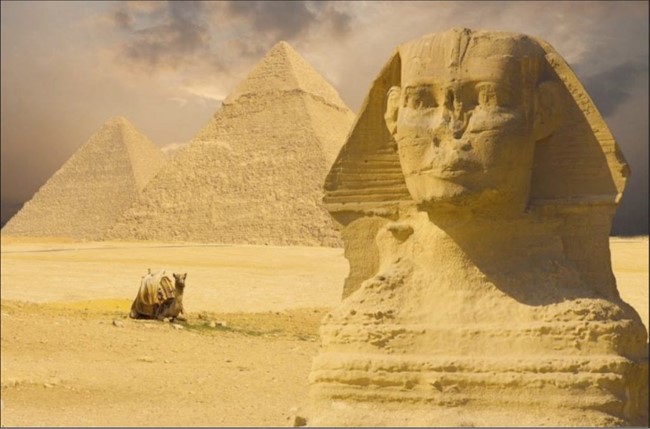
The Sphinx of Giza with the Pyramids in the background
The accuracy and reliability of Plato as a historian has in many respects been able to be verified only during the last century, thanks to numerous archaeological findings. His description of the sacred spring whose waters flowed through the Acropolis, for example, had always been considered entirely mythological, until fragments of Mycenaean vases, dating back to the 13th century BC, depicting a source in the in the middle of the Acropolis, an event that has forced scholars to look at his writings in a new light. Then, in 1938, further excavations made it possible to discover that in ancient times, following an earthquake, a spring that was located near the Acropolis had closed, exactly at the point indicated by Plato. And in the 1950s a team of Greek, German and American archaeologists was able to verify that the picture of Athens from the 5th century BC. matched Plato’s description with astonishing accuracy. According to Joseph, both the identification of the sacred source of the Acropolis and the precise description of the urban structure of Athens would testify in favor of Plato’s historical reliability.
Robert Catesby Tagliaferro, one of the greatest and most esteemed classical philologists in the United States, in his preface to a 1944 edition of Thomas Taylor’s translation of Timaeus and Critias [9], in reference to the history and events of Atlantis narrated by Plato he expressed himself like this: “It seems to me a testimony as authentic as any other historical narration of antiquity. We must not forget that we are dealing with Plato, or the one who proclaimed that truth is at the origin of all good among the Gods as among men, and who in all his works never stopped looking for errors and analyzing the truth. How can we imagine that he was the one who purposely deceived humanity, publishing an imaginative novel and disguising it as an accurate historical account?”.
It is therefore difficult to believe that Plato wanted to enrich his narration with such a mass of historical, geographical and mythological details for the sole purpose of creating an allegorical fiction.
Another great philologist and Greek scholar, Enrico Turolla, one of Plato’s most learned and esteemed commentators and translators, also expressed himself firmly in favor of the historical reliability of Timaeus and Critias. Indeed, as Turolla has pointed out [10], Plato’s exposition proves to be a detailed and at the same time sober and concrete dissertation, aimed at highlighting the characteristics of the country of Atlantis, with a whole series of precise indications on the position of the disappeared island, defined literally as “the passage to a great opposite continent”: America, unknown – at least officially – to the ancient Mediterranean peoples. Indications, therefore, of which probably not even Plato could really understand how true he was. Neither Plato and nor Sonchis, the priest of Sais who according to Plutarch had reported certain news to Solon. Both one and the other, according to Turolla’s opinion, appear to be only faithful echoes that transmit news spreading from remote antiquity. And their great merit is not only that they believed, but that they were faithful in transmitting something that they very probably did not fully understand.
The accuracy and reliability of Plato as a historian has in many respects been able to be verified only during the last century, thanks to numerous archaeological findings.
At this point Turolla, as reported by Roberto Pinotti in his essay The Lost Continents [11], reminds us that for the ancient Greeks, in accordance with the Egyptian historical-mythical tradition fully accepted by Plato, there had existed at the beginning of time a real theocracy, in the sense that there had been an ancestral era in which men were directly governed here on Earth by the Gods, a golden age whose memory has remained in a large part of the mythological-religious traditions of the planet, during which the Gods were present, visible and tangible, and in which the King-Shepherd of the land of Atlantis was Poseidon, from whom came and descended those Kings and Queens who gave rise to the Atlantean dynasties. Similarly, in Egyptian religious texts and papyri we often read of the Zep Tepi, of that “First Time” in which Osiris and other Gods ruled Egypt during a first and long-lived Golden Age. For the ancient Egyptians it was a certainty that the Gods had long ago established the system of cosmic order and transferred it to their land. The Gods had ruled Egypt for many millennia, before entrusting it to the mortal yet divine line of Pharaohs. The Pharaohs, for their part, represented the priestly link with the Gods and, by extension, the link with the First Time, of which they kept the laws and knowledge of wisdom.
Turolla always points out that in the Critias and in the Timaeus the names of the places and of the characters are, yes, Greek, but Plato himself takes care to warn us that they had already been translated into Egyptian from the Saitic source and that then Solon, with the intention to make a poem out of this subject, he had transposed them into Greek, in the form in which Plato has since taken them up again.
Turolla then lists in his text numerous elements of the Platonic narration which find objective evidence, also in relation to a comparative analysis between the Hellenic and Near-Eastern mythological tradition and that of the Amerindian natives and notes in the content of the two dialogues “too precise” indications , with an accuracy of terms such that only in our days, after the discovery of America, can it be understood and appreciated as a whole. Today, for example, we know that the historians of the Spanish conquest of Mexico in the 16th century described Tenochtitlán, the then capital of the Aztecs, as surrounded by canals and concentric basins with a sacred island in the center and that this typology of construction recalled for them the memory of their original and lost homeland, Aztlan, described by the ancient Aztec traditions, “a land on great waters”, in the “eastern sea” (the Atlantic Ocean). A land told by them, but also represented, as an island with a mountain surrounded by concentric rings of walls and canals. At this point, it is impossible not to make a comparison with the complex structure of concentric walls and wide navigable canals that Plato, in his narration, attributes to the capital of Atlantis.
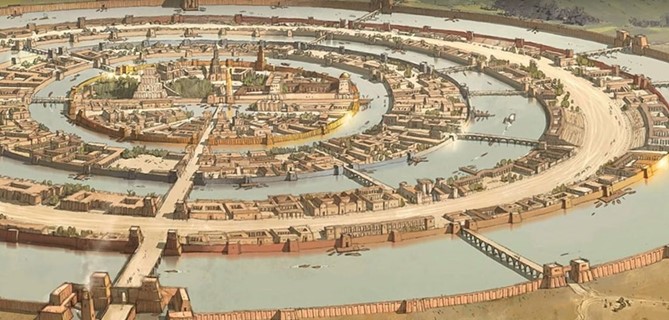
The capital of Atlantis; source: YouTube/Bright Insight
Aztlan, according to ancient Amerindian traditions, was destroyed by a catastrophe in a remote era, sinking into the waves of the sea. Even the Popol Vuh, sacred text of the Maya narrates that “the waters, raised from the heart of the sky, boiled and a great deluge came upon all creatures” and that the surviving Gods, having arrived from the sea and landed on the coasts of Mexico, brought with them their development and knowledge. And the Codex Troano, an ancient Mayan manuscript which is part, together with the Codex Cortesianus, of the larger Code of Madrid, tells of a great catastrophe that would have upset the world in the remote past, while an inscription of the Temple of Palenque tells of a horrible earthquake that lifted and sank the earth like the waves of the sea, with smoke and rivers of fire. Not to mention the Atzech calendar code Chimalpopoca, which in a part known as Leyenda de los Soles (“The Legend of the Suns”) tells of how “the sky descended towards the water and in one day everything disappeared…“.
The testimonies and references listed so far regarding the memory, present in the mythological-religious traditions of the peoples of Mesoamerica, of an ancient homeland of disappeared origin and sank under the waters of the ocean following a huge cataclysm, as noted by the historian Boris Yousef, would certainly have been much greater if the Spanish conquistadors and the “missionaries” following them had not systematically destroyed or burned 99% of the sacred texts and manuscripts of these populations!
Enrico Turolla then returns to focus on the question of the “great opposite continent” mentioned by Plato in the following passage from the Timaeus: “In those distant times it was possible to cross that immense sea [the Atlantic Ocean, editor’s note], because in it there was a island; and this island was in front of that narrow mouth which has the name, as you say Pillars of Hercules. And it was, this island, bigger together than Libya and Asia. And to whoever proceeded from that, the passage was opened to other islands, and from these islands to a great opposite continent, around what is really the sea“.
As it is evident, the “great opposite continent” is precisely America and “what is really sea” can only be the remaining part of the ocean that stood between the islands of Atlantis and the American coasts. And in Turolla’s opinion, these few lines would be enough to eliminate any possibility of discussion. This is not about fantasy; on the other hand no one in the Mediterranean at Plato’s time could (at least officially) know this. How can we fail to conclude that, if the news on the American continent is true (as it is), so too must all the details on Atlantis be true?
«In those distant times it was possible to cross that immense sea, because in it there was a island; and this island was in front of that narrow mouth which has the name, as you say Pillars of Hercules. And it was, this island, bigger together than Libya and Asia. And to whoever proceeded from that, the passage was opened to other islands, and from these islands to a great opposite continent, around what is really the sea»
Well, here we are faced with an evident paradox: on the one hand we have a large group of eminent and esteemed historians and philologists (Thomas Taylor, Robert Catesby Tagliaferro, Frank Joseph, Boris Yousef, Enrico Turolla and many others who for reasons of space I have not mentioned, including Albert Rivand, Zadenk Kukal and Ivan Lissner) who do not hesitate to defend the historical reliability and the plausible veracity of the Platonic narration on “Atlantis”; on the other hand we have instead a compact wall of “academic” archaeologists who consider Critias and Timaeus tout-court works of mere fantasy and who refuse regardless and out of prejudice to even consider the idea of the existence of a advanced civilization in a time before what they consider the current line of
civilization!
Which is the purpose, Turolla always wonders, if some so clear-cut and precise details were a pure game of fantasy? What purpose would the measures and the subdivision of the territory have, the detailed description of the buildings, the concentric canals and the irrigation systems, the equally precise description of the religious rites and ceremonies and other completely useless details if they were not corresponding to the truth?
The Platonic writings in question therefore present an evident descriptive nucleus, to which is added (and here Plato’s effective personal contribution can be recognized) another nucleus, of a narrative nature, concerning a historical event in which that civilization of whose geographical and political characteristics are thus minutely described. However, Turolla observes again, the historical part relating to “Atlantis” and its civilization seems to have had no development, it is simply stated. Accomplished, in fact, his detailed description of Atlantis”, when Plato is about to begin the narration of other events of a historical or war nature, the text of the Critias, as suddenly as inexplicably, stops. It is known that a third dialogue, entitled Hermocrates, should have joined, in Plato’s intentions, the Timaeus and the Critias, providing more information about the mythical disappeared land and its history.
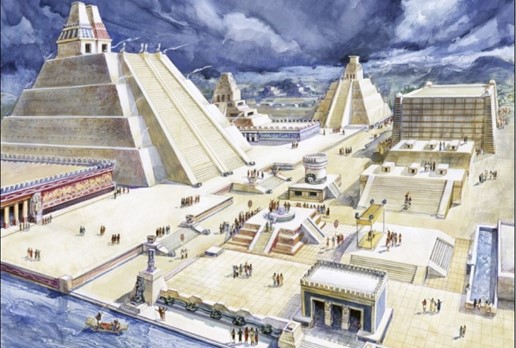
Reconstruction of a district of the Aztec capital Tenochtitlan as it appeared before the Spanish conquest
Some historians, including Boris Yousef, have hypothesized that Hermocrates may have actually been written by Plato, but that it was already made to disappear in antiquity due to the “dangerousness” of its contents. But this, unfortunately, in the absence of objective evidence, remains only a hypothesis. Turolla has a different opinion, highlighting the importance of this interruption. In his opinion, it would be a very important test that assures us of the veracity of the whole descriptive nucleus. Plato would indeed have prepared the narrative of the war, but he would have done so until the moment in which he was alive with the expectation of exposing the part coming from the Egyptian priestly source. Once the exposition was complete, Plato, who could not be interested in vague
fantasies, would have suddenly cut everything short. In short, when the support of the source disappeared (due to the limitation or incompleteness of the information about Solon that Plato had acquired), interest and dialogue also vanished, and the trilogy itself (the Timaeus, the interrupted Critias and the – perhaps – never written Hermocrates), significantly defined as “Atlantica” as proof of the weight attributed by the Author to the information on the lost land, was to remain forever unfinished.
But, like many contemporary historians and philologists, many scholars of antiquity also believed the Platonic narrative on “Atlantis” to be absolutely truthful and worthy of faith, in the same way as any other historical narrative. In classical antiquity, in fact, with rare and sporadic exceptions, no one doubted the historicity of Timaeus and Critias and there was a widespread belief that Plato was inspired by real documents and more ancient traditions. Also because, at the time in which this narration was accepted not only as a maieutic-philosophical teaching but also as a historical event, there were many other proofs in circulation in favor of its authenticity. As Frank Joseph points out, the geographer Posidonius of Rhodes firmly believed in the existence of the mythical lost land and conducted his research in Cadiz, the Gades del Crizia, in relation to the Atlantean kingdom of Gadeiros. And in this regard Strabone noted: “He was right (Posidonius, ed.) to cite Plato’s opinion, according to which the tradition concerning the island of Atlantis should be considered something much more concrete than a legend”[12].
A vast group of ancient authors including Theophrastus (student of Aristotle, who was more than twenty years old when Plato died), Thucydides (contemporary of Plato), Theopompus of Chios, Posidonius of Rhodes (who wrote around 70 BC), Tertullian , Diodorus Siculus, Strabo, Pomponius Mela, Pliny the Elder, Seneca, Claudius Aelianus, Philo of Alexandria, Ammianus Marcellinus, Syrianus and Iamblichus notoriously considered Atlantis a historical reality and not a fiction.
In confirmation of the truthfulness and reliability of the Platonic narratives on “Atlantis”, it is also interesting what Proclus always tells us in his Commentary on the Timaeus, namely that the philosopher Crantore da Soli, first commentator on Plato, a pupil of Xenocrates and a member of the Academy of Athens, personally wanted to go to Egypt in search of confirmation of the news collected by Solon and then inserted by Plato in his famous dialogues: “Crantor adds that all this is confirmed by the prophets of the Egyptians, who affirm that the details, as well as Plato narrated them, they are engraved on some columns that are still preserved”[13].
Crantor, therefore, as Proclus tells us – a source which, however late, is considered authoritative and worthy of faith – personally found in Egypt the confirmations he was looking for, confirmations that in his time were still perfectly visible and accessible. The works of Crantor, including one of his amous Commentary on the Timaeus, have unfortunately been lost, but their existence was well known until the Roman Imperial Age.
And, again Proclus, in his Commentary on the Timaeus, writes: “According to him (Iamblichus, ed.), and also according to our tutor Syrian, certain contradictions and oppositions are not introduced with the aim of rejecting the narration, since on the contrary it is recognized that such is the account of true events”. And again, mentioning a work by the geographer Marcellus unfortunately now lost, Proclus writes: “That such a large island once existed is evident from what certain historians say about the Outer Sea. According to them there were seven islands in that sea in their time, sacred to Persephone, and also three others of immense size, one of which was sacred to Pluto, another to Ammon, and the one in the middle to Poseidon, and its length was a thousand stadia. They add that its inhabitants retained the memory of their ancestors, or of the Atlantic Isle which existed there, and which was indeed prodigiously large; which for many periods had dominion over all the islands of the Atlantic Sea, and it too was sacred to Poseidon. These things, therefore, Marcellus wrote in his Ethiopian History. If however this is the case, and if such an island once existed, it is possible to accept what is said of it as history (…). And so, concerning much of what is said of the greatness of Atlantis Isle, to show that it is not right not to believe what was said by Plato, and that it must be accepted as true history.”
At this point it is also necessary to decisively debunk the erroneous, but all too widespread, belief that, outside Plato’s Timaeus and Critias dialogues, there is no ancient first-hand reference to “Atlantis”, or whatever one wants to call this great disappeared civilization north Atlantic. A belief, as we will see, deeply mistaken, but continuously fueled by certain “academic” archaeologists who, instead of dedicating themselves to diligent excavations and new discoveries in the interest of all humanity, set themselves up as professional deniers.
«That such a large island once existed is evident from what certain historians say about the Outer Sea. According to them there were seven islands in that sea in their time, sacred to Persephone, and also three others of immense size… They add that its inhabitants retained the memory of their ancestors, or of the Atlantic Isle which existed there, and which was indeed prodigiously large…»
Regardless of the fact that on the occasion of the Panathenaic festivities (Παναθήναια), which were held every year in Athens in honor of Athena Poliade as protector of the city, women wore peplums embroidered with symbolic motifs, some of which depicted the victory of Athens over Atlantis (and this already happened before the birth of Plato), if we exclude the Texts of the Archaic-Scholarly Discipline of the Eleusinian schools (because, as we have explained, having reached us through multiple transcriptions, they cannot constitute proof), already, before of Plato, there were numerous works that made direct reference to “Atlantis” or in any case to a great previous civilization tragically swallowed up by the ocean following a terrible cataclysm. We are, for example, aware of a work written several decades before the birth of Plato by Hellanicus of Lesbos, a work which was entitled Atlantis, unfortunately lost, but mentioned by numerous ancient sources. Not to mention the Journey to Atlantis by Dionysius of Miletus, a Greek historian and logographer who lived between the 6th and 5th centuries BC; a work focused on the history and description of the vanished continent which may not have been excluded, like the information inherited from Solon, one of the primary sources used by Plato for drafting his dialogues. This text, considered lost until the 1960s, was at the center of an incredible story that should make us think. A handwritten copy, apparently from the Byzantine era, of Dionysius of Miletus’ Journey to Atlantis was found in the personal library of the French historian and writer Pierre Benoit after his death in 1962 in Ciboure, a small town on the Atlantic side of the Pyrenees. The news caused quite a stir at the time, not only due to the historical importance of the find, but also because Benoit is
known for having written, in 1920, a famous novel, L’Atlantis, for the drafting of which he was perhaps inspired precisely by the manuscript of Dionysius. It has never been explained how and where Benoit acquired that manuscript, but it is believed that he acquired it in the early 1900s on the antiques market in North Africa, where he served extensively in the army. But the shocking aspect of the story is that the manuscript in question was officially “lost” in the various passages between the restorers
and the people who took it into custody after Benoit’s death. It is therefore probable that it is still today in the hands of private individuals or, worse, of institutions or organizations that are anything but willing to make it public precisely because of its very existence. Making a text that traces the history of Atlantis prior to Plato’s dialogues usable by the public would in fact bring down many of the house of cards of the paladins of the “paradigm”.
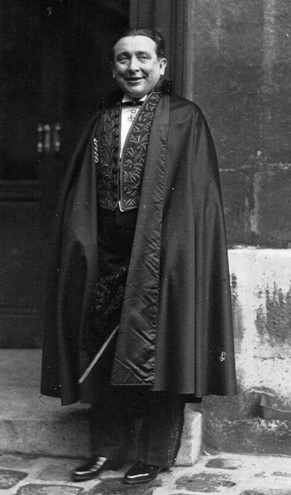
Pierre Benoît in 1932; source: Wikicommons
Recapitulating and drawing some conclusions, Plato, on the basis of the information inherited from Solon and of which he himself most likely received full confirmation during his long stay in Egypt, in his dialogues Critias and Timaeus calls and describes as “Atlantis” (Ἀ- τλαντὶς) a land beyond the Pillars of Hercules on which a previous great civilization had flourished, and tells us how it sank among the waves of the Ocean following terrible earthquakes and floods, for a sort of “revenge” or divine “punishment”, exactly nine millennia before his time.
Plato in his dialogues does not speak of “Seven Great Islands”, but limits himself to describing a single large island-continent with a capital city named “Atlantis”. In the Eleusinian context we believe that Plato decided to call the land that disappeared under the waves of the ocean with this denomination precisely because of the incomplete, or in any case partial and third-hand information that he had collected, as the Ennic civilization, as described to us by Uelesh, Rhashamele’sh and the other authors to whom the Texts of the Archaic-Scholarly Discipline are attributed, never called itself, as we have already highlighted, “Atlantis” or “Atlantean”. Plato, therefore, precisely because of the incompleteness of his information, referred to the Ennic region of Hath-Lan-Thiv-Jhea or to the large and flourishing city of Hath-Lan-Thiv-Hesh, also called in the Texts “The White”, which stood on the oceanic coast of the Ennosigeo? Both hypotheses are quite probable, but personally we lean towards the second one, resulting in Hath-Lan-Thiv-Hesh a city which, on the basis of the description provided to us by Rhashamele’sh, substantially corresponds to the one described by the Platonic narration.
With all due respect to many pseudo-historians and more or less improvised contemporary researchers, who would stubbornly claim to place the facts narrated and described by Plato in a Mediterranean context, even awkwardly assuming that the great Philosopher-Initiate was wrong and intended to write nine centuries rather than nine millennia before his era (which is absurd in itself!) and that he intended instead to refer to the eruption of Santorini, which around the sixteenth century BC. it devastated
Crete and a large part of the eastern Mediterranean, the numbers add up, and they add up in a mathematical way.
In fact, science has recently ascertained and demonstrated that, just around 9,600 BC, a second major comet impact occurred, considered even more devastating than the first. A cometary impact that seriously shook the world at the time with nothing short of apocalyptic consequences, even causing a shift in the Earth’s axis and suddenly putting an end to the small ice age of the Recent Dryas, which had begun following the previous cometary impact, that of 10,800 BC And the sudden end of the Recent Dryas also determined the melting of enormous glaciers that covered a large part of the northern hemisphere, causing a rise in the level of the seas and oceans estimated by scientists to be between 150 and 200 meters, which submerged a large part of the coastal stretches of the Earth, numerous islands and part of continental masses, inexorably annihilating any civilization found there. An event that has been remembered and handed down by all the cultures and traditions of the Earth as a great flood!
It is no coincidence, in fact, that we can find clear references to a cataclysmic flood in the myths and traditions of as many as two hundred and thirty cultures spread across all continents.
Notes
- Plutarch of Chaeronea: Parallel Lives – Life of Solon, XXVI.
- Ibidem, XXXI.
- Herodotus: Histories, I, 30; Diodorus Siculus: Historical Library, I°, 96.2 and 98.1.
- Strabo: Geography, book XVII°.
- Roger Godel: Platon à Heliopolis d’Egypte. Ed. Belle Lettres, Paris 1956.
- Paul Jordan: The Atlantis Syndrome. Ed. Sutton Publishing Limited, London 2001.
- Frank Joseph: The Truth About Plato. In J. Douglas Kenyon: The Forbidden History. Macro Editions, Cesena 2008.
- William Bleckett: Lost History of the World. Ed. Truebner & Sons, London 1881.
- Thomas Taylor – Robert Catesby Tagliaferro: The Timaeus and the Critia, or Atlanticus. Ed. Panthon Books, New York 1944.
- Enrico Turolla (edited by): Plato, the Atlantis: selected readings from the Timaeus and the Critias. Ed. Garzanti, Milan 1947.
- Roberto Pinotti: The lost continents. Ed. Mondadori, Milan 1995.
- Frank Joseph: Work cited.
- Proclus: Commentary on Plato’s Timaeus, Book I°, 76, 1-15. ↑

